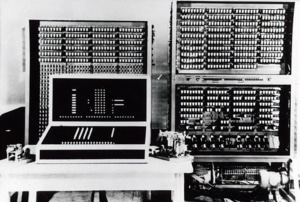DCPA NEWS CENTER
Enjoy the best stories and perspectives from the theatre world today.
Enjoy the best stories and perspectives from the theatre world today.
Gutenberg! The Musical! – showing at the Garner Galleria Theatre through May 4 – is the meta spoof story of two playwrights auditioning a play about German inventor Johannes Gutenberg and his printing press, hoping to get a Broadway debut.
Speaking of German inventors and inventions, we use numerous everyday inventions that you probably didn’t know had German roots, from Gummy Bears and TVs to airbags and more.
Let’s look at these inventions and their German inventors.
 Dr. Hans Riegel of Bonn, Germany, CEO of HARIBO (named after his father and hometown, HAns RIegel BOnn) created a gummy candy in 1922 that resembled a tanzender Bär (German for “Dancing Bear”). Today, these candies are known as Gummy Bears worldwide. Flavors include pineapple, cherry, orange, strawberry, and more.
Dr. Hans Riegel of Bonn, Germany, CEO of HARIBO (named after his father and hometown, HAns RIegel BOnn) created a gummy candy in 1922 that resembled a tanzender Bär (German for “Dancing Bear”). Today, these candies are known as Gummy Bears worldwide. Flavors include pineapple, cherry, orange, strawberry, and more.
By 1994, HARIBO produced more than 70 million gummy bears daily and had more than 5,000 employees in several global plants and offices.
German physicist Manfred von Ardenne built an early vision of the television in 1934. He also created radio mechanisms and medical equipment, such as gear for lung diagnostics and an electronic microscope.
He had over 600 patents.
German inventor and engineer Walter Linderer patented the first design for a safety cushion, which we now consider to be the first car airbag. However, the seat cushion failed because the driver couldn’t activate it.
American John Hetrick designed and patented the first successful “airbag” in 1953.
While Germans didn’t invent beer, they did improve the quality of the popular brew. Wilhelm IV and Ludwig X, Dukes of Bavaria, ordained a beer purity law in 1516, requiring people to only brew beer with barley, hops, and water. The law is still in effect today throughout Germany. Yeast wasn’t included for fermentation until 1906.
Some believe this law intended to ban unhealthy or unwanted features from beer.
Wilhelm Conrad Röentgen – born in Remscheid, Germany – discovered X-rays accidentally while experimenting with fluorescence in vacuum tubes. He noticed rays emitting from the tube made a shadow image on light-sensitive paper.
Röentgen produced an image of his wife’s hand to follow up on his discovery. This discovery allowed doctors to look at the body without invasive or exploratory surgeries. Röentgen won the Nobel Prize for Physics in 1901 for his work.
Sports fanatic Adolf Dassler – after having a falling out with his brother and the Nazi party during World War II – created the first Adidas shoe from aircraft fuel liners, rubber rafts, and tent canvases since leather was in short supply. He developed the distinctive three-strap sneakers and logo in 1949.
Adidas was intended for athletes but became popular in the Hip-Hop scene, especially after the 1986 debut of Run-D.M.C.’s song “My Adidas.”

Aspirin is great for alleviating headaches, fevers, and inflammatory issues. Felix Hoffmann, from Ludwigsburg, Germany, was a pharmacist-turned-chemist who studied under Professor Adolf von Baeyer.
On August 10, 1897, Hoffmann acetylated salicylic acid with acetic anhydride to create acetylsalicylic acid (ASA), which could lower fevers, relieve pain, and be an anti-inflammatory substance. By 1928, Hoffmann retired and Aspirin was a worldwide phenomenon.
German engineer Konrad Zuse created the Z3 – the first functional computer – in 1941 after the Z1 was subpar. The Z3, the first program-controlled processor, was destroyed during a 1945 Berlin air raid.
Zuse created the Z4 model and more after that.
Melitta Bentz (1873-1950), a Dresden, Germany housewife, was tired of making dirty coffee. She created the first two-part coffee filtration system by punching holes in a brass pot and adding a piece of paper to it.
Bentz’s invention led to the founding and launch of the Melitta Group of Minden, Germany. To this day, Melitta’s North America and Canada locations sell pour-over coffee brewing systems, coffee, and coffee filters.
 Lastly, Karlheinz Brandenburg from Erlangen, Germany, co-created the MP3 format, which allows us to listen to music on MP3 devices like Apple’s iPods and iPhones.
Lastly, Karlheinz Brandenburg from Erlangen, Germany, co-created the MP3 format, which allows us to listen to music on MP3 devices like Apple’s iPods and iPhones.
Brandenburg obtained a Ph.D. in electrical engineering from Friedrich-Alexander University Erlangen-Nuremberg for his digital audio coding and perceptual measurement techniques in 1989.
These techniques led to the creation of the MPEG-1 Layer 3 (MP3), MPEG-2 Advanced Audio Coding (AAC), and other modern audio compression methods and file formats. The Internet Hall of Fame inducted Brandenburg in 2014.
Ok, you got me.
We may not use or even think about Albert Einstein’s Theory of Relativity every day. Nevertheless, it exists because of his immense research and dedication. Einstein’s theory for physics was what Steve Jobs was to Apple or what Motown was to music – a revolution.
Special relativity explains how speed affects mass, time, and space. It also discussed the speed of light, leading to the well-known formula: E=mc2.
